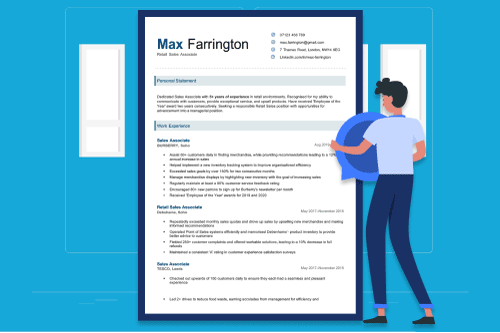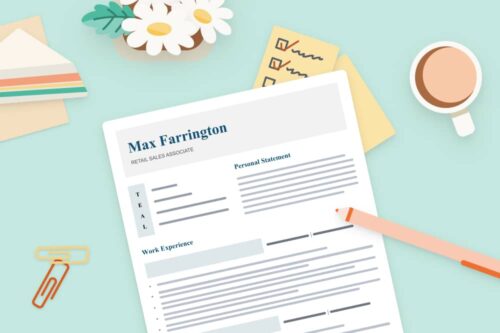In the UK, an address on a CV is a common personal detail to add to a CV. That’s why CV templates usually have a spot for your location (address), like so:
But is telling employers your address on your CV before they hire you really a good idea? Whether you should put your address on your CV depends on your situation. Here’s when you should and shouldn’t:
Do include your address on a CV when:
- the job advert includes a location requirement and you meet it
- you want to make it easier for the employer to do a background check
- a short commute is one of your selling points
Don’t include your address on a CV if:
- you’re concerned about privacy
- you’re applying for a remote job without a location requirement
- you want to hide a lengthy commute
Once you’ve determined whether revealing your location is necessary when you’re writing your CV, here are your options for putting an address on a CV (or not):
Click on each option to learn more about when you should use it and how:
- Including your full address (e.g., 14 Aga Street, Beaconsfield, H9J 3K4)
- Putting in your town only
- Stating your relocation plans or availability (e.g., ‘willing to relocate’ or ‘relocating to [town] in [time frame]’)
- Leaving your address off your CV
1. Including your full address
You should include your full address on a CV if:
- the job advert specifically says to
- the company prefers applicants who live in a certain area
- your short commute to the office is one of your selling points (e.g., living within walking distance ensures you won’t be late to work because of car troubles or delayed public transport, underscoring your dependability)
- your most recent work experience is overseas, and you want to emphasise that you’re currently living in the UK
If you don’t mind letting your target employer know where you live, you can follow this example of how to put a full address on a CV:
And if you live in a big city and want to emphasise your close proximity to an employer, you can include your neighbourhood, like this:
45 Templeton Drive, Chelsea, London, SW3 5ES
2. Putting in your town only
If you don’t want to give employers your full address, you can still let them know you’re in their general area by just putting your town on your CV. Reasons for only placing your town on your CV include:
- hiding a long commute (e.g., you live in Enfield and the company you’re applying to is a 1.5-hour drive away in Croydon, so you just list ‘London’)
- showing an employer hiring remote workers within the UK that you live in the UK
- maintaining some privacy while providing your general location
If you still want to let employers know you’re in their general area, you can do so by just putting your town (not your full address) on your CV like this:
3. Stating your relocation plans or availability
Are you applying to jobs all over the country (or even the world)? Don’t let your address on your CV disqualify you. Instead, let the recruiter know you’ll go wherever the work is by writing ‘Willing to relocate’ where you’d normally place your address.
Or if you’re planning a move to where the employer is, start your CV by writing something like this to let the employer know you’ll be in the right place at the right time: ‘Moving to [Town] in [Month Year]’.
This is how a relocation statement looks on a CV:
4. Leaving your address off your CV
Unless the job advert specifically tells you to, it’s okay not to include your address on a CV. So just delete your location from your CV’s personal information section if you’re:
- concerned about privacy
- unable to meet the employer’s location requirements but want to try to convince them to make an exception
- needing space on your CV for more job-relevant information
And this is how a CV header looks without an address:
3 tips on how to put your address on your CV
Here are three tips for including your address in a CV’s layout (or skip the work and use an online CV creator that automatically formats your address for you):
1. Use proper postal address formatting
Show your professionalism and attention to detail by using the right format for the address on your CV. So, write it like you would when you’re addressing an envelope:
Number & Street Name, Town, Postcode (e.g., 47 Preston Lane, Wrexham, LL11 1PA)
And if you’re not including your full address on your CV, delete the items you don’t want to reveal, but keep the remaining information in the same order. For instance:
Bristol, BS6 5XX
Marylebone, London
2. Put it with the rest of your contact information
Once you have your address formatted properly, it’s time to put it in your CV. It’s not complicated — just put it with the rest of your contact information. We suggest placing it after your phone number and email, which are more important because the employer will use one of them to contact you. But you can move your address up if you want to ensure the employer sees where you’re located.
3. Use a CV icon to make your address easy to find
Help the employer see where you live by using a CV icon to make your address stand out.
You can download CV icons and add them to your contact details yourself — just make sure you download icons of the same style for the rest of your personal information so everything in the section matches. But the easiest way to use icons is to find a CV template with built-in icons. Doing so ensures your CV appears professionally formatted.
FAQs related to putting an address on a CV
Still searching for answers to your CV address question? Here are answers to 5 frequently posed questions related to including an address on a CV:
- How do I put my LinkedIn address on my CV?
- Should I put my address on my cover letter?
- Should I include two addresses on my CV?
- What address should I use if I’m homeless?
- Can I use abbreviations or initials in my address?
1. How do I put my LinkedIn address on my CV?
Here’s how you put your LinkedIn address on your CV:
- Open your LinkedIn profile
- Go to ‘Edit public profile & URL’
- Replace the string of random numbers and letters LinkedIn automatically adds to your URL with whatever combination of your name, initials, and/or job title that hasn’t been taken yet (e.g., ‘ben-underwood-093hjB’ → ‘ben-underwood-designer’)
- Click ‘Save’
- Copy everything after the ‘www.’ (including the entire URL will create a link in your CV, which appears unprofessional)
- Paste your LinkedIn address into your CV’s contact information section
Here’s a video that shows you how:
2. Should I put my address on my cover letter?
If you put your address on your CV, then yes, put it on your cover letter too. But if you don’t put your address on your CV, then leave it off when you build your cover letter as well.
Keeping your CV format and cover letter structure consistent shows your attention to detail. And if you want to emphasise your location to the employer, putting your address on both of your application documents increases the chances they see it.
The easiest way to use consistent formatting is to use a cover letter template that matches your CV’s design.
3. Should I put two addresses on my CV?
A Reddit user asked this question.
No, you should not put two addresses on your CV. Even if you have two addresses (for example, you have a home address and a uni address), just put the address that’s closest to the company or organisation you’re applying to. Doing this will save space and reduce confusion for the recruiting manager.
4. What address should I use if I’m homeless?
Another Reddit user posed this question.
If you’re homeless, consider using a:
- PO box address
- family member or friend’s address
- church’s address (most are happy to do this, but give them a head’s up so they don’t return your post to the sender)
5. Can I use abbreviations or initials in my address?
This question comes from Quora.
Yes, you can. Using initials helps save space on a CV. Here are some common address abbreviations in the UK:
- St — Street
- Rd — Road
- Co. — County
- Ln. — Lane
- W., E., N., S. — West, East, North, South
- Ave. — Avenue
For example: 47 E. Hampton Rd, Spennymoor, Co. Durham, DL16 9ZZ









